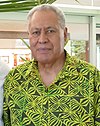O Le Ao O Le Malo
The O le Ao o le Malo (Samoan for Chief of the government) is the ceremonial head of state of Samoa.
The position is described in Part III of the 1960 Samoan constitution. At the time the constitution was adopted, it was anticipated that future heads of state would be chosen from among the four Tama a 'Aiga "matai" paramount chiefs in line with customary protocol. This is not a constitutional requirement, so Samoa can be considered a parliamentary republic rather than a constitutional monarchy. The government Press Secretariat describes Head of State as a "ceremonial president". The holder is given the formal style of Highness, as are the heads of the four paramount chiefly dynasties.
| O le Ao o le Malo of the Independent State of Samoa | |
|---|---|
| O le Ao o le Malo o le Malo Saʻoloto Tutoʻatasi o Sāmoa | |
 | |
 | |
| Style | His Highness |
| Type | Head of state |
| Residence | Vailele |
| Seat | Apia |
| Appointer | Legislative Assembly |
| Term length | Five years, renewable once |
| Constituting instrument | Constitution of Samoa |
| Inaugural holder | |
| Formation | 1 January 1962 |
| Deputy | Members of the Council of Deputies |
| Salary | US$82,000 annually |
| Website | www.samoagovt.ws |
Members of the Council of Deputies act as deputy heads of state, standing in for the head of state when they are unable to fulfil their duties, such as when the Head of State is either absent or ill.
The current O le Ao o le Malo is Tuimalealiʻifano Vaʻaletoʻa Sualauvi II, who was elected to a five-year term which started on 21 July 2017. Tuimalealiʻifano was re-elected to a second five-year term on 24 August 2022, and renewed his oath of office on 19 October.
History of the office
When Western Samoa became independent on 1 January 1962, the 1960 Constitution jointly named two of the four paramount chiefs (Tama a 'Aiga) to the office for life: Tanumafili II and Tupua Tamasese Meaʻole. They represented, respectively, the Malietoa and Tupua Tamasese, "two of the four main family lineages" of Samoa. They were jointly known as O Ao o le Malo and individually as O le Ao o le Malo. Mea'ole died a year later in 1963, leaving Malietoa Tanumafili II as the sole holder of the office until his death in 2007, aged 94. His replacement, Tui Ātua Tupua Tamasese Efi, had served two prior terms as Prime Minister and is the elder son of Tupua Tamasese Meaʻole. He was elected by the Samoan Legislative Assembly for a five-year term beginning on 20 June 2007 and again in July 2012 for a further five-year term. The 4th and current Head of State, Tuimalealiʻifano Vaʻaletoʻa Sualauvi II, the great grandson of Mau movement leader Tuimaleali'ifano Fa'aoloi'i and nephew of the original member of the Council of Deputies Tuimaleali'ifano Suatipatipa II, succeeded Tui Ātua Tupua Tamasese Efi after election by the Legislative Assembly for a five-year term on 30 June 2017 when Tui Ātua Tupua Tamasese Efi's term was nearing its end.
In 2019, the Samoan government amended the constitution, introducing term limits for the head of state. Once a head of state has completed their first five-year term, they are only eligible for reappointment once. Thus each head of state is permitted to serve for a maximum of ten years.
The official residence of the head of state was the former home of writer Robert Louis Stevenson, until it was damaged in cyclones in the 1990s; the building subsequently became the Robert Louis Stevenson Museum.
In November 2021, the Samoan government announced that it was considering an amendment to make the office of the O le Ao o le Malo a lifetime appointment. This suggestion was part of a review of the constitution.
Qualifications
Article 18 of the Samoan constitution sets the qualifications for the position of Head of State. He must:
- be qualified for election as a member of parliament;
- possess such qualifications as the Fono may determine by resolution;
- not have previously been removed from the office on the grounds of misbehavior or infirmity.
Term of office
The Head of State is elected by the Fono for five years and can be re-elected once. The exceptions to this were Tanumafili and Meaʻole, who were exempted from the five-year term laid down by Article 19. A 2019 amendment to the constitution states that the Head of State can serve no more than two terms. There was an understanding that the office is to rotate among the four tama aiga families, of which the most recently elected Head of State belongs to the Tuimaleali'ifano clan, one of the four paramount chiefs alongside the Mataʻafa (a vacant chieftaincy since 2014).
Removal from office can occur in four ways:
- resignation;
- removal by the Fono on the grounds of misbehavior or mental or physical infirmity;
- approval by two-thirds of the Fono of a resolution for removal that is proposed and supported by at least a fourth of its members following at least fourteen days between the notice of motion and debate on the motion;
- death.
Duties and powers
The position is that of a ceremonial Head of State, while actual power is held by the Prime Minister, whom the Head of State appoints on the recommendation of the Fono. While the Head of State "does not play an active role in government", they can dissolve the Fono and no act of parliament will become law without their approval - akin to royal assent in monarchies. The Head of State may also grant pardons.
Elections
To date, there have been four elections for the office of Head of State. The first was held on 16 June 2007, in which Tui Ātua Tupua Tamasese Efi was elected unopposed by the 49-member strong parliament. The second was held on 19 July 2012, in which Efi was nominated by Prime Minister Tuila'epa Sa'ilele Malielegaoi and seconded by Palusalue Faʻapo II, the leader of the opposition. The third was held on 30 June 2017, in which Tuimalealiʻifano Vaʻaletoʻa Sualauvi II was elected unopposed. The fourth was held on 23 August 2022, in which Sualauvi II was reelected unopposed.
List of officeholders
- Status
- Symbols
C Constitutional referendum
† Died in office
| No. | Portrait | Name (Birth–Death) | Elected | Term of office | Political party | Prime minister(s) | ||
|---|---|---|---|---|---|---|---|---|
| Took office | Left office | Time in office | ||||||
| 1 |  | Tupua Tamasese Meaʻole (1905–1963) | 1961[C] | 1 January 1962 | 5 April 1963[†] | 1 year, 94 days | Independent | Mulinuʻu II |
| 1 |  | Malietoa Tanumafili II (1913–2007) | 1 January 1962 | 11 May 2007[†] | 45 years, 130 days | Independent | Mulinuʻu II Lealofi IV Tupua Kolone Alesana Tuila'epa | |
| — |  | Tui Ātua Tupua Tamasese Efi (born 1938) Acting O le Ao o le Malo | — | 11 May 2007 | 20 June 2007 | 40 days | Independent | Tuila'epa |
| — |  | Tuimalealiʻifano Vaʻaletoʻa Sualauvi II (born 1947) Acting O le Ao o le Malo | 11 May 2007 | 20 June 2007 | Independent | |||
| 2 |  | Tui Ātua Tupua Tamasese Efi (born 1938) | 2007 2012 | 20 June 2007 | 21 July 2017 | 10 years, 31 days | Independent | Tuila'epa |
| 3 |  | Tuimalealiʻifano Vaʻaletoʻa Sualauvi II (born 1947) | 2017 2022 | 21 July 2017 | Incumbent | 6 years, 20 days | Independent | Tuila'epa Mataʻafa |
Notes
Timeline

See also
References
External links
This article uses material from the Wikipedia English article O le Ao o le Malo, which is released under the Creative Commons Attribution-ShareAlike 3.0 license ("CC BY-SA 3.0"); additional terms may apply (view authors). Content is available under CC BY-SA 4.0 unless otherwise noted. Images, videos and audio are available under their respective licenses.
®Wikipedia is a registered trademark of the Wiki Foundation, Inc. Wiki English (DUHOCTRUNGQUOC.VN) is an independent company and has no affiliation with Wiki Foundation.
